The Deadly Toll of Ivermectin: Blindness, Comas & Deaths Induced By The Neurotoxic, Genotoxic Poison
Dissenters & Conservatives Are Being Culled By Ivermectin Shills
Full documentary based on this article is available now: https://www.youtube.com/watch?v=5DwzMP08NGs or https://rokfin.com/post/177153/The-Deadly-Toll-of-Ivermectin-Blindness-Comas--Deaths-Induced-By-The-Neurotoxic-Genotoxic-Poison
Fruit Bat Ivermectin Poisoning: Sudden Onset Of Blindness, Paralysis & Death
In a paper called ‘Ivermectin toxicosis after topical administration in dog-faced fruit bats (Cynopterus brachyotis)’ by DeMarco et al (Full report)
39 bats were administered 1 drop of “propylene glycol ivermectin solution for use in cattle” on the skin of the chest.
“The following morning, 11 of the bats had fallen from their perches and were lying either on the ground or in their food bowl, unable to move. Six bats recovered within 24–48 hr. Two days later another animal was found in a food bowl.”
“Five adult male dog-faced fruit bats… the sudden onset of generalized paralysis”
“Three bats died, and one was euthanatized 1 day after admission, and Bat E, evaluated 5 days after the ivermectin treatment because of severe weakness, died spontaneously 7 days after topical ivermectin treatment”
Hundreds of Comas in DNC Reported To Ivermectin’s Passive Reporting System
In a study called ‘Analysis of severe adverse effects following community-based ivermectin treatment in the Democratic Republic of Congo’ by Bof et al. researchers queried a passive reporting system for Ivermectin. Like any passive reporting system, we should always question whether there is a huge underreporting factor that needs to be accounted for.
“Some factors such as being a male, being over 18 years of age, alcohol consumption and hemp (cannabis) intake 24 h before ivermectin administration were associated with the occurrence of SAE.”
Severe adverse effects reported after ivermectin treatment:
594 Coma Reports
235 Severe Headache Reports
13 Paralysis Reports
476 Motor Deficit Reports
Ivermectin Serious Adverse Event Analysis
In an article called ‘Serious adverse events following treatment with ivermectin for onchocerciasis control: a review of reported cases,’ researcher Twum-Danso goes through passive reported serious adverse events for Ivermectin.
Here is a distribution of the # of reports by age bracket with a peak in the age ranges 15-30 and 30-45 years:
“For more than half of the cases (n = 118; 57%), the SAE occurred following their first exposure to ivermectin. The mean time from ivermectin treatment to onset of symptoms was 2.2 days (95% CI: 1.8, 2.5)”
Of the cases with altered mental status when first encountered by a clinician (n = 106), 52 were confused, obtunded or lethargic while 16 presented with stupor and 38 presented in frank coma.
The top 10 presenting symptoms were: Difficulty or inability to stand or walk, Feverishness, Headache, General myalgia or arthralgia, Fatigue/Asthenia, Diarrhea, Vertigo, Dyspnea, Pruritis, Nausea or vomiting
The top 10 presenting signs were: Altered Mental Status, Fever, Incontinence (urinary or fecal), Dysarthria, Subconjunctival hemorrhage, Rash and/or urticuria, Generalized edema, Extremity edema, Facial edema, Hypotension
“The clinical outcome of the SAE cases was documented for 137 of the 207 total cases (66%). As shown in Table 6, for those whose outcome is known, the majority of cases recovered fully. There were a total of 28 deaths, corresponding to a cumulative case-fatality rate of 20.4% if only the cases where outcome is known are included in the analysis (n = 137).”
Ivermectin Induced Blindness For 5 Cats
In a study called ‘Retinopathy associated with ivermectin toxicosis in five cats’ (full report) by Guess and Rankin
“Five domestic shorthair farm cats … sudden onset of tremors, obtundation, blindness, and dilated pupils. Less than 12 hours earlier, the owner had attempted to treat the cats for a suspected ear mite (Otodectes cynotis) infestation by aural administration of a dose of an ivermectin paste intended for oral administration to horses (approx 22 mg/cat; half of the dose was administered into each ear canal).”
“Neurologic examination revealed generalized body tremors, mild obtundation, and bilateral ear twitching. Mydriasis in ambient light, diminished (sluggish and incomplete) pupillary light reflexes, and lack of menace response were also detected.”
“In the left eye of the fifth cat, several abnormalities were evident. Retinal responses were abnormal in all cats (Figure 1). Responses were diminished in 7 eyes and totally eliminated in 1 eye (the left eye of the cat with retinal detachment). ”
“Reports of ivermectin toxicosis are common for dogs and less common for cats. This type of toxicosis has also been reported for equids (neonatal foal, adult horses, and miniature mule foal). Clinical signs include blindness, mydriasis, ataxia, lethargy, tremors, and coma, and toxic exposure may result in death. Affected dogs may develop blindness without other clinical signs.”
Ivermectin-induced “Acute Onset Blindness” In A Jack Russell Terrier Dog
In a paper called ‘Ivermectin-induced blindness treated with intravenous lipid therapy in a dog’ by Epstein and Hollingsworth (full report)
“Jack Russell Terrier was examined for acute onset of apparent blindness after being exposed to ivermectin the previous day. The dog appeared to be blind during initial examination. Pupillary light reflex, menace response, and dazzle reflex were not present in either eye… Electroretinography (ERG) showed diminished activity in both eyes.”
“Ivermectin-induced blindness occurred in 22% of suspected or diagnosed canine ivermectin toxicosis cases reported to the Animal Poison Control Center”
Ivermectin Induced Blindness In African Lion
In a paper called ‘Successful management of ivermectin-induced blindness in an African lion (Panthera leo) by intravenous administration of a lipid emulsion’ (full report):
“A 2-year old captive African lion (Panthera leo) weighing ~130 kg was admitted to Veterinary Medical Teaching Hospital.. for the treatment of acute neurological impairments, including ataxia, apparent hallucinations, generalized seizures, disorientation and bilateral blindness.”
“Extremities were cold to touch”
“Ophthalmic examination indicated diminished menace response, direct and indirect pupillary and palpebral reflexes in both eyes”
“Intermittent twitching of the muscles surrounding shoulder and gluteal regions along with periodic jerking of the head were recorded. Both superior and inferior lips were flaccid and had proprioceptive deficits along with evident limb weakness in all limbs”
Coma Severe Ivermectin Toxicity for Boy With ABCB1 Mutation
In a paper called ‘Serious Ivermectin Toxicity and Human ABCB1 Nonsense Mutations’ a case study is examined by which a 13 year old boy was sent to the hospital in a coma after just one ivermectin pill.
“His condition worsened 6 hours after he received ivermectin, with persistent neurologic signs, including coma, ataxia, pyramidal signs, and binocular diplopia, as well as abdominal pain and vomiting.”
“He had received a single oral dose of ivermectin (0.23 mg per kilogram of body weight) to prevent scabies infection 2 hours 30 minutes before the onset of impaired consciousness.”
“Ivermectin intoxication was suspected, since encephalopathy and coma are well-known side effects of ivermectin treatment in animals and the usual causes of coma had been ruled out.”
Nursing Home Horrified When 32% Of Seniors Treated With Ivermectin For Scabies Died
In a paper called ‘Deaths associated with ivermectin treatment of scabies’ by Barkwell and Shields (full report)
“On Nov 10, 1995, all residents were treated with a single oral dose of ivermectin (150–200 μg/kg of body weight)… Over the succeeding 6 months, there was a pattern of excess deaths among the 47 residents who had received ivermectin. We retrospectively constructed a 47-patient cohort of those who had not had scabies for comparison purposes… we deliberately maximised the number of deaths in the comparison [control] group. Between Nov 10, 1995, and May 10, 1996, 15 of the 47 who had received ivermectin died, compared with five of the age-matched and sex-matched cohort.”
“Those in the ivermectin group developed a sudden change in behaviour with lethargy, anorexia, and listlessness which preceded death”
Seizures, Encephalopathy & Coma In Ivermectin Dosed Patients
In a paper called ‘5PSQ-157 Severe neurotoxicity of oral ivermectin: a systematic review of case and case series reports’ (full report)
“The outcome of interest was cases of severe neurotoxicity (SN) in adult/adolescent patients (>11 years) treated with ivermectin.”
“6 cases and 11 cases series reports in patients treated for strongyloidiasis, onchocerciasis, loiasis and scabies infections reported SN occurrence such as consciousness disorders, seizure or convulsion, encephalopathy and coma. SN [severe neurotoxicity] not only was associated with Onchocerciasis treatment in Loa loa coinfected patients.”
“Chandler RE reported 28 SN [severe neurotoxicity] cases after ivermectin use outside the Onchocerciasis indication and Nzolo D et al reported cases of SN [severe neurotoxicity] even with low blood levels of Loa loa microfilari”
“2 studies associated SN [severe neurotoxicity] with the presence of ABCB1 mutation. Baudou E et al reported the case of patient with two human ABCB1 mutations who suffered SN and Bourguinat C et al showed homozygotic haplotypes associated with alterations in drug disposition in 2 cases.”
“SN [severe neurotoxicity] after ivermectin use must be detected early to avoid fatal consequences. Authors related this toxicity with human ABCB1 nonsense mutations that allow ivermectin penetration into the central nervous system. This could be a future field of research”
Ivermectin Induced Depression And Death In Baboons
In a paper called ‘Ivermectin treatment of Loa loa hyper-microfilaraemic baboons (Papio anubis): Assessment of microfilarial load reduction, haematological and biochemical parameters and histopathological changes following treatment’ (full report)
“Haemoglobin (Hb) levels which recorded a significant (p = 0.028) drop post treatment”
“All animals became withdrawn 48 hours after IVM administration. All treated animals recorded clinical manifestations including rashes, itching, diarrhoea, conjunctival haemorrhages, lymphnode enlargement, pinkish ears, swollen face and restlessness; one animal died 5 hours after IVM administration.”
“Macroscopic changes in post-mortem tissues observed comprised haemorrhages in the brain, lungs, heart, which seen in all groups given ivermectin but not in the untreated animals.”
“The number of mf seen in the brain and kidneys of animals administered IVM alone tripled that of control animals. Co-administration of IVM+PSE caused a greater increase in mf in the brain and kidneys”
“Bab 08 (with an initial Loa mf load of 124,700 mf/mL) became unbearably restless, lost appetite and died 5 hours after treatment.”
Ivermectin Toxicity On Cats: 3 Case Studies
3 case studies were presented by Muhammad et Al in an article called ‘Use of neostigmine in massive ivermectin toxicity in cats’ (full writeup here)
In the first two case studies someone injected their two kittens with 15 mg of Ivermectin each (later we find one kitten only got half dose). Both cats experienced major negative effects. Both kittens became comatose and died.
“After about 2 hours, the… kitten became comatose, started salivation and died after 1/2 hour”
“The presented kitten also started salivating about 2 hours of the ivermectin administration, developed ataxia but retained some conscousness and rightening response. The next morning it was found comatose. Examination… revealed mild salivation, mydriasis, coma, slight fever (102.4F), and an accelerated respiration rate. Severe tachycardia, the heart rate being almost uncountable. It died 12 hours [later]”
Why did one cat fare a little better? Well the owner says their was an administration mistake: “about half the ivermectin injection spilt on the ground”
In the 3rd case study, a larger, older cat was injected with 15mg Ivermectin.
“Excessive salivation, wet chin, lacrimation, dehydration, mydriasis with poor pupillary reflex, protrusion of third eye lid and increased respiration (42 breaths per minute) and heart rates (128 per minute)… staggering gate and tremors … ataxic”
By 5 days after the injection of Ivermectin and treated for its toxicity, the cat fully recovered.
CNS Depression From Pairing Ivermectin With Pgp Inhibitor Thiopentone
In a paper called ‘Central and Peripheral Neurotoxic Effects of Ivermectin in Rats’ by Trailovic and Nedeljkovic:
“10 mg/kg resulted in sleepiness and staggering 10 to 40 min after application, while a dose of 15 mg/kg caused CNS depression very similar to general anesthesia.”
“Rats treated with 10 mg/kg of ivermectin demonstrated sleepiness and staggering during the 10 to 40 min after drug administration. However, the highest tested dose of ivermectin, 15 mg/kg, caused CNS depression very similar to general anesthesia. Mean sleeping time in treated rats (n=15) was longer than 4 hr, but three rats died.”
This is very concerning because of the large number of people taking potent Pgp/ CYP3A4 inhibitors such as CBD, THC, K2, curcumin, Vit A, grapefruit juice, quercetin, milk thistle, hot peppers etc.
VigiBase Adverse Event Database Shows Many Ivermectin Comas & Seizures:
In an article called ‘Adverse drug reactions associated with ivermectin use for COVID-19 reported in the World Health Organization's pharmacovigilance database’ researchers Campillo & Faillie say that there were 6 reported deaths to which Ivermectin was the single suspect JUST for people using Ivermectin in an attempt to fight Covid.
“From May 1st 2020 to December 21, 2021, a total of 1777 cases were reported with ivermectin specifying an indication for COVID-19. Gastrointestinal and neurological effects were the most reported. Among 53 cases considered as serious, the most frequently reported concerned neurologic disorders (11 cases including 1 encephalitis, 1 coma and 1 death), respiratory disorders (8 cases including 2 deaths), gastrointestinal disorders (8 cases including 1 death) and cardiac disorders (5 cases including 2 deaths by cardiac arrest). Four overdoses were reported and were mostly associated with neurologic disorders. Among these 4 cases, 2 were life threatening and 1 caused/prolonged a hospitalization. Table 1 summarizes characteristics of the 35 serious cases (including 6 deaths)”
“Among the 6 deaths, 4 were male and 2 were female, 1 patient was 20-years-old, 4 were between 50- and 80-years-old, and 1 patient was of unknown age. For 3 cases, death was the only term reported. The other 3 cases report the following PTs:
confusional state, septic shock and digestive disorders;
abnormal state sensation and acute respiratory distress syndrome;
cardiac arrest, serious myasthenia and nervous system disorder.”
“These findings call for extreme caution when using ivermectin”
Vigiaccess Database
VigiAccess gives us some insights into the WHO’s adverse event database. Of note in the list of adverse drug reaction reports for ivermectin:
47 Coma Reports
32 Depressed Levels Of Consciousness
55 Vision Impairments
49 Blurred Vision
25 Seizures
24 Loss Of Consciousness
20 Encephalopathy
8 Blindness
9 Cardiac Arrest
5 Cardiac Failure
1 Cardiac Failure Acute
2 Cardio Respiratory Arrest
1 Blindess Unilateral
Ataxia, Coma & Death: Neurotoxic Effects Of Ivermectin In Pigeons
In a paper called ‘Clinical And Histopathological Investigation Of Ivermectin Toxicity In Pigeons’ by Waleed (full report)
“The histopathological changes included degeneration of nerve fibers of spinal cord and sciatic nerve. Degeneration , necrosis and vacuolation were noticed in liver, kidney and heart, as well as proliferation of bile duct was also seen in liver.”
“Clinical sings of ivermectin toxicity included ataxia, sedation, tremor, coma, somnolence and listlessness were developed 4 hours post s/c injection of 8 mg ivermectin /kg bw.Five bird of group A were dead after 48 hour of dosing.”
“The group B exhibited more severe clinical signs than that of group A. All birds of group B died after 40 hour of dosing with 10 mg ivermectin /kg bw.”
Encephalopathy, Seizures & Bilateral Vision Loss In Man Double Dosed With Ivermectin
In a paper called ‘Post-ivermectin encephalopathy in Senegal: a case report’ by Massi et al:
“We report the case of a 35 years old patient living in rural areas of Senegal who presented two days after a mistake in administration of a second dose of ivermectin, headaches, altered consciousness and bilateral blindness.”
“The workup revealed brain white matter lesions, abnormal liver function tests and biological inflammation”
“The clinical examination revealed headaches, tonic-clonic seizures, obtundation (Glasgow coma score of 10/15), bilateral visual loss and unreactive mydriasis…”
“We should therefore carefully control the administration of this drug”
Reduced Egg Production, Comas & Deaths In Ivermectin Dosed Chickens
In a paper called ‘Clinical signs of ivermectin toxicity and the efficacy of antigabaergic convulsants as antidotes for ivermectin poisoning in epileptic chickens’
“With higher doses of ivermectin body weight, egg production and feed and water consumption were markedly reduced. Severe diarrhea, mydriasis, bradypnea, ataxia, sedation, coma and death occurred with the highest dose of ivermectin.”
“Severe Neurological Toxicity” In Ivermectin + CYP3A4/ Pgp Inhibitor Dosed Mice
In a paper called ‘The effect of ivermectin alone and in combination with cobicistat or elacridar in experimental Schistosoma mansoni infection in mice’ researchers exposed rats to 1000 μg/kg of ivermectin orally daily for three days and also tried pairing the Ivermectin with a CYP3A4 and P-gp inhibiter called Elacridar.
“By inhibiting the P‑glycoprotein or cytochrome P450 3A in mice host or parasites in a murine model, we aimed at increasing the sensitivity of S. mansoni to the drug and thus preventing infection.”
“Most mice treated with ivermectin and elacridar suffered severe neurological toxicity. In conclusion, systemic treatment with ivermectin, even in the presence of pharmacological inhibition of P‑glycoprotein or cytochrome P450 3A, did not result in effective prophylaxis for S. mansoni infection in an experimental murine model.”
“After administering the combination of ivermectin and elacridar… the animals showed seizures, circular movements, and loss of ambulatory capacity. Six animals in the ivermectin and elacridar group died or were euthanized according to the end-point rules of the protocol. Only four out of ten mice survived the administration of the ivermectin and elacridar drug combination.”
“the combined use of ivermectin and P-gp inhibitor elacridar led to seizures and disturbances in movement defined as final point criteria in most animals in the treated group”
CNS Depression & Decreased Locomotion/ Rearing Behavior In Rats
In a paper called ‘Possible Anxiolytic Effects of Ivermectin in Rats’ by Spinosa et al (full report):
“In the open field, 1.0 mg/kg ivermectin decreased locomotion frequency at 15 and 60 min of observation, rearing behaviour showed a biphasic effect at 15 and 30 min and duration of immobility was increased in all sessions after 1.0 mg/kg ivermectin. These data suggest anxiolytic or sedative effects.”
“In conflict behaviour analysis, ivermectin and diazepam gave the classic effect of an anxiolytic drug, reversing the conditioned response to shock.”
“The results of the open field behavioural studies showed that ivermectin reduced general activity”
“Rearing frequency was also significantly reduced at 15 min after the administration of 0.5 or 1.0 mg/kg of ivermectin and at 30 min after the administration of the 0.5 mg/kg dose.”
“The decrease in general activity in the rats observed in the open field after the administration of ivermectin suggests that the drug produces depressant effects on the central nervous system”
Case Reports Of Depression & Ataxia In 3 Ivermectin Dosed Horses
In a study called ‘Ivermectin toxicosis in three adult horses’ by Swor, Whittenburg & Chaffin" (full report):
“Adult Quarter Horses were evaluated for acute, progressive neurologic signs 18 hours after oral administration of 1 dose of 1.87% ivermectin paste.”
“Clinical signs included depression, forelimb and hind limb ataxia, drooping of the superior and inferior lips, and muscle fasciculations. Bilateral mydriasis, decreased pupillary light reflexes, and absent menace reflexes were evident. Clinical signs progressed in severity for 36 hours after administration of the ivermectin.”
“Approximately 18 hours after administering the ivermectin paste, the owner noticed signs of depression, profuse salivation, and ataxia in all 4 limbs of horse 1 and the other 2 horses that received the same dewormer.”
“One horse was euthanized, and a high concentration of ivermectin was detected in its brain tissue at postmortem examination”
Ivermectin Dosed Zebrafish Lose Startle/ Hyperlocomotion Response
In a paper called ‘Zebrafish behavioral response to ivermectin: insights into potential neurological risk’ by Powrie et al. (full report)
“At doses proven to have anti-viral activity, ivermectin poses significant neurotoxicity risk. Ivermectin’s neurotoxicity risk profile may be worse when the blood brain-barrier is compromised during viral infection. Exposure to ivermectin early during development may pose significant risk of long-term neurological limitations.”
“For both treatments, the startle response was observed in the lower (0.1 and 0.5 μg/ml) doses at the acute time point, but not in the higher (1 and 10μg/ml) doses. Of interest, only the lowest dose retained this startle response at 3hr (Fig. 2b,e), with a similar outcome observed for both IVM and V-IVM. In contrast, at 24hr (Fig. 2c,f), the startle response appeared to have been recovered in the V-IVM-treated larvae for the 0.5 μg/ml dose, but not in the IVM group.”
“In terms of the hyperlocomotion response, only the two lowest doses of V-IVM did not result in inhibition of the immediate hyperlocomotion response, with both higher doses resulting in an immediate relative unresponsiveness (visible as similarly low activity levels in both light and dark cycles) (Figs. 2a and 3a), which expanded to the 0.5μg/ml dose by 3hr (Figs. 2b and 3b).”
“all V-IVM treatment doses – with the exception of the lowest dose employed – significantly reduced basal activity status (ANOVA main effect of dose, p < 00001) and was associated with a relative absence of anxiety-associated hyperlocomotion response in the light–dark assay on day 5 post fertilisation, when compared to untreated controls”
Ivermectin Proves Effective For Rapid Euthanization Of Blue Crabs
In a paper called ‘EVALUATION OF INTRACARDIAC ADMINISTRATION OF POTASSIUM CHLORIDE, IVERMECTIN, OR LIDOCAINE HYDROCHLORIDE FOR EUTHANASIA OF ANESTHETIZED BLUE CRABS (CALLINECTES SAPIDUS)’
“Intracardiac… ivermectin at 5 mg/kg was effective, rapid method for euthanasia of anesthetized blue crabs
Human Ivermectin Trial Had Massive 34% Dropout Rate For “Tolerability Issues”
34% of test subjects in the 1.2 mg/kg ivermectin arm dropped out of the trial.
“Discontinued treatment: 1 (3.1%) in arm A; 2 (6.9%) in arm B; and 11 (34.4%) in arm C. The interruptions in arm C were all due to tolerability. Seven participants received only 1 day of treatment, three participants received 2 days and 3 days”
383.5% Increase In Severe Adverse Effects In C19 Ivermectin Trials
Serious Neurological Impairments In Ivermectin Dosed Patients
In a paper called ‘Serious Neurological Adverse Events after Ivermectin—Do They Occur beyond the Indication of Onchocerciasis?’ (full report)
Encephalopathy and Coma In Ivermectin Dosed Woman, A Case Report
In a case report called ‘Ivermectin Poisoning — Report of Successful Management’ by Talwar et al (full report)
“After four hours of consumption [30 mg/kg of ivermectin], she had two episodes of vomiting followed by generalized tonic-clonic movements and loss of consciousness. On arrival, she was unresponsive, with Glasgow Coma Scale (GCS) 6/15, with tachycardia, tachypnea, hypotension and oxygen saturation of 79% at room air. Pupils were equal bilaterally (3 mm) with sluggish reaction.”
“There was generalized hypotonia with absent deep tendon reflexes and fundoscopic examination was normal. Excessive salivation and bilateral crepitations were present.”
“We suspected ivermectin poisoning due to the history, since encephalopathy and coma are well-documented side effects of ivermectin treatment in animals”
9 Year Old Child Experiences Blurry Vision, Ataxia, Dizziness & Balance Issues
In a case report called ‘Acute Visual Disturbances and Ataxia Secondary to Attempted COVID-19 Prophylaxis With Ivermectin in a Nine-Year-Old’ by et al
“The child was given 60 mg (1 mg/kg) of veterinary-grade ivermectin by a parent… as prophylaxis”
“Ten hours later, the child developed new-onset blurry vision, a perception of red dots in the peripheral vision, dizziness, and balance issues. Physical examination was notable for pulsating pupils, ataxia, and dysmetria."
Severe Problems Including Coma & Death After Ivermectin In South Cameroon
In a paper called ‘Severe adverse reaction risks during mass treatment with ivermectin in loiasis-endemic areas’ by Chippaux et al (full report)
“In South Cameroon, several patients presented severe problems days to weeks following ivermectin treatment.”
“One of these patients died 23 days after the dosing.”
“We observed clinical and biological inflammatory signs (fever, headache, myalgia, arthralgia, increase of C-reactive protein), renal impairment (proteinuria, haematuria) and neurological disorders (asthenia, reduction of activity, stupor)”
“One of them presented in stage 2 coma, ie. he reacted to aching stimulation but was unable to respond to questions”
14 Year Old’s Onset Of Psychosis Post Ivermectin Dosing
In a paper called ‘Increased risk of psychosis to ivermectin treatment’ by Calderon et al (full report)
“Presented to ER with 2 week of treatment to ivermectin 6mg for pediculosis; presenting first psychotic episode. She presented first clinical outbreak of psychosis characterized by mystical-religious, erotomaniac, harm and reference delusions, auditory and visual hallucinations adding isolation, abulia, apathy, dialogued soliloquies, and spontaneous crying.”
“Diagnostic impression: Acute polymorphic psychotic disorder with symptoms of schizophrenia”
“Possible causes were analyzed, finding a relationship with ivermectin treatment.”
Psychosis Post Albendazole + Ivermectin Combination Dosing
In a paper called ‘Drug-induced psychosis associated with albendazole–ivermectin combination therapy’
“She presented to the emergency department of a tertiary neuropsychiatric hospital with an abrupt-onset illness of 3 days' duration. Her problems characterized by persecutory beliefs against her family, suspicious behavior and hearing voices unheard by others. She was also reported of showing aggressive behavior and disturbed sleep and appetite. On exploration, it was reported that approximately 24 h prior to onset of symptoms she had ingested a single dose of a commercial drug formulation of albendazole 400 mg and ivermectin 12 mg for suspected gastrointestinal worm infestation, prescribed by a general physician”
Right On The Fact Sheets: “May Cause Serious Brain and Nerve Problems”
According to IBM Watson Micromedex, a drug information database used by many sites like Drugs.com among many warnings and side effects, one really stands out:
“[Ivermectin] may cause serious brain and nerve problems”
According to Merck’s Ivermectin fact sheet:
“Causes damage to organs (Central nervous system) if swallowed”
And the Ivermectin fact sheet warns:
“Long-term studies in animals have not been performed to evaluate the carcinogenic potential of ivermectin.”
“Ivermectin has been shown to be teratogenic in mice, rats, and rabbits when given in repeated doses of 0.2, 8.1, and 4.5 times the maximum recommended human dose, respectively (on a mg/m^2/day basis). Teratogenicity was characterized in the three species tested by cleft palate; clubbed forepaws were additionally observed in rabbits. There are, however, no adequate and well-controlled studies in pregnant women. Ivermectin should not be used during pregnancy since safety in pregnancy has not been established.”
PubChem warns that Ivermectin is acutely toxic:
Acute Toxicity Of Ivermectin In Rat Study
In a study called ‘Comparative evaluation of acute toxicity of ivermectin by two
methods after single subcutaneous administration in rats’ by Dadarkar et al, researchers tried to calculate the amount of IVM it takes to kill Adult Sprague Dawley is a single injection (full report)
“Immediately after drug administration all the rats receiving high dose exhibited swelling at the site of injection… Cage side observations indicated immediate local
scratching of the area in which drug was administered which lead to mutilation of variable degree in individual rats. Mutilation was manifested for 2–3 h, which caused bruises and oozing of serosanguinous fluid”
“The rats exhibited depression, staggering, ataxia, incoordination, loss of righting, prostration, bradycardia and death (in that order). The rats exhibited bleeding from medial canthus of eyes and those, which survived, showed depression, but only for first 24 h. The degree of depression was directly proportional to the dose administered.”
“The LD 50 of the test formulation of ivermectin was found to be 51.5 mg/kg.”
50% population death at just one dose of 51.5 mg/kg! For context, a U.S. dime weighs approximately 2.268 grams, or 2268 mg.
Please remember certain animals have Pgp deficiencies or are taking Pgp inhibitors, making them much more susceptible to ivermectin toxicity. More about that here.
Acute Abamectin Poisoning For 29 Year Old Woman: Ataxia & Unable To Walk
In a study called ‘Acute abamectin toxicity: a case report’ by Piraseth et al (full report)
“She was transferred from local hospital to our emergency unit with nausea, vomiting and altered consciousness four hours after acute ingestion of abamectin poisoning with suicidal intent. Upon examination, her Glasgow Coma Scale (GCS) was 10/15, and her bilateral pupils were 5 mm with sluggish reaction to light. She had ptosis of both eyes. She was ataxic and unable to walk.”
Comas, Respiratory Failures & Death (Multiple Organ Failure) After Abamectin & Ivermectin Exposure
In a case report called ‘Agricultural avermectins: an uncommon but potentially fatal cause of pesticide poisoning’ by Chung et al, researchers reviewed and compiled 18 cases of patients with abamectin expose and 1 case related to ivermectin (full report)
“Seven patients manifested severe symptoms, such as coma (7), aspiration with respiratory failure (4), and hypotension (3), after a mean ingestion of 100.7 mg/kg avermectin (15.4 mg/kg for ivermectin and 114.9 mg/kg for abamectin).”
“1 patient died 18 days later as a result of multiple organ failure.”
“Conclusion: Ingestion of a large dose of avermectin may be associated with life-threatening coma, hypotension, and subsequent aspiration.”
Lethal Dose Of Ivermectin In Mice: And The mdr1a Gene Mutation Results In Death At 1% The Dose
In a 1994 paper called ‘Disruption of the mouse mdr1a P-glycoprotein gene leads to a deficiency in the blood-brain barrier and to increased sensitivity to drugs’ by Schinkel et al, researchers calculated the lethal dose thresholds for 2 polymorphisms of mice: mdr1a (+/+) & mdr1a (-/-) (full report):
LD50 = Dosage that kills 50% of recipients
LD10 = Dosage that kills 10% of recipients
The dosage required to kill 10% of mice is 98.6% less in the mdr1a (-/-) polymorphism vs the mdr1a (+/+) polymorphism.
In argument against the 0.15 mg/kg usage of ivermectin regularly used in Africa, the researchers noted “it is dangerously close to the lethal dose in mdr1a (-/-) mice (0.8 mg/kg).”
Ataxia & Semicomatose In Ivermectin Dosed Dog
In a paper called ‘Ivermectin toxicosis in a dog’ by Houston, Parent & Matushek:
“Within 2 hours of oral administration of ivermectin, the dog had hind limb ataxia. Neurologic signs progressed rapidly until the dog was in a semicomatose state at admission 20 hours later.”
“Clinical signs were similar to those reported in dogs with clinical and experimental exposure to ivermectin.”
Ataxia, Recumbency, Blindness, Seizures & Comas In Ivermectin Dosed Dogs
In a meta-study called ‘Ivermectin Toxicosis in Dogs: A Retrospective Study’ by Merola, Khan & Gwaltney-Brant (full report):
“Ivermectin is a commonly used veterinary drug that may cause serious problems in overdose situations… Results showed that clinical signs may be seen in some animals at doses lower than previously reported. Some dogs may have p-glycoprotein defects or other reasons for increased susceptibility to ivermectin toxicosis. The clinician should be aware that clinical signs may develop even at dosages previously thought to be of little risk (e.g., 0.2 to 2.5 mg/kg in breeds historically considered to have normal p-glycoprotein function).”
“The most frequent clinical signs reported to the APCC in both groups included ataxia, lethargy, mydriasis, hypersalivation, tremors, and recumbency [Table 3]. Ataxia was the most common sign reported in 105 (61%) of 172 symptomatic dogs, followed by lethargy (n=52; 30%), tremors (n=51; 30%), mydriasis (n=38; 22%), and blindness (n=38; 22%) … recumbency (9% in NPD dogs; 27% in PD dogs) and seizures (4% in NPD dogs; 20% in PD dogs)”
“Ataxia was reported in a broad range of dosages, from as low as 0.08 mg/kg”
“Lethargy, tremors, and mydriasis were also seen over a similarly broad range of dosages. Death and euthanasia occurred most frequently at dosages >1 mg/kg”
“Death occurred in three PD [P-glycoprotein defect] dogs. Two dogs in the PD group were reported to have been euthanized. One of these dogs became comatose after ingesting 0.15 mg/kg of ivermectin.. The other PD dog that was euthanized ingested 2.5 mg/kg of ivermectin and developed ataxia, tremors, and bradycardia”
“Of the NPD dogs, death occurred at dosages between 1 and 2.5 mg/kg in two dogs and at unknown dosages in two dog; all of these dogs showed signs of CNS depression, ataxia, mydriasis, and tremors or disorientation. Seven of the NPD dogs were reported to have been euthanized.”
“No Response To Any External Stimuli” In Iverectin Dosed Doberman Pinscher
In a paper called ‘Ivermectin toxicosis in a dog’ by Hopkins, Marcella & Strecker (full paper)
“A 5-year-old male Doberman Pinscher was examined after ingesting an equine paste dewormer containing approximately 115 mg of ivermectin. Clinical signs consisted of profound hypothermia, mild dehydration, dilated unresponsive pupils, localized muscle group fasciculations around the face and hind limbs, and no response to any external stimuli. Twelve days after parenteral administration of isotonic fluids and IV administration of dexamethasone and dimethyl sulfoxide, the dog returned to a clinically normal neurologic state.”
Ivermectin Induced Stupor and Coma In Adult Collies
In a paper called ‘Ivermectin toxicity in 17 Collies’ by Hopper & Aldrich (full report):
“Two groups of Collies were presented to the University of California Veterinary Medical Teaching Hospital (VMTH) with ivermectin toxicity.”
“Group I comprised 5 adult Collies that received at least 400 microg/kg ivermectin p.o. and were presented to the VMTH 3 hours after intoxication. These Collies showed marked clinical signs on presentation. Three of these dogs required mechanical ventilation and were euthanized for financial reasons; the remaining 2 dogs were comatose but recovered in 5-7 days. Group II was comprised of 12 adult Collies presented to the VMTH 2 days (n = 10) and 5 days (n = 2) after subcutaneous injection of 200-250 microg/kg ivermectin. These animals showed greater variation in severity of illness among individuals; 5 animals progressed to stupor or coma, whereas 4 animals remained ambulatory. Most of these dogs' clinical signs deteriorated from the day of intoxication until approximately day 6, from which time they showed gradual but steady improvement… it took 3 weeks for most of them to recover.”
Severe Ataxia & Muscle Tremors In Australian Shepherd
In a paper called ‘Ivermectin toxicity in an Australian Shepherd dog with the MDR1 mutation associated with ivermectin sensitivity in Collies’ by Nelson et al (full report):
“The dog was treated with ivermectin at approximately 200μg/kg SC, and topical fipronil. The dog also was vaccinated fordistemper, adenovirus, parainfluenza, parvovirus, and leptospirosis. A few days later, the dog represented to the referring veterinarian for hypersalivation and restlessness. On physical examination, the dog was reported to be severely ataxic with episodic muscle tremors”
“Over the next several days, the dog’s condition deteriorated. Ataxia worsened, and an apparent loss of vision was detected. Direct and indirect pupillary light reflexes were intact, but no menace response was observed”
“On day 5 of hospitalization, no improvement in neurologic status was observed. Physostigmine (0.04 mg/kg IV q12h) was administered because the dog’s condition continued to deteriorate”
Meta Study Of Blindness, Comas & Other Neurotoxicities Of Ivermectin In Dogs In Cats
In a paper called ‘Ivermectin and piperazine toxicoses in dogs and cats’ by Lovell (full report)
“Review of all reports involving anthelmintics in dogs and cats to the IAPIC between January 1, 1986 and August 10, 1988, revealed that ivermectin (extra-label use) and piperazine accounted for over 50% of the calls assessed as toxicoses and suspected toxicoses.”
“Both ivermectin and piperazine are gamma-aminobutyric acid (GABA) agonists and their major effects appear to be on the central nervous system.”
“Ataxia, behavioral disturbances, tremors, mydriasis, weakness/recumbency, apparent blindness, hypersalivation/drooling (dogs only), and coma were the most commonly reported clinical signs in dogs and cats with suspected ivermectin toxicoses. Shock, dyspnea, vomiting, and ataxia were the most common clinical signs attributed to the microfilaricidal activity of ivermectin.”
Sudden Onset Blindness In Two Dogs After Ivermectin Poisoning
In a paper called ‘Retinopathy associated with ivermectin toxicosis in two dogs’ (full report):
“2 dogs were examined for sudden onset of blindness. Both dogs had mild obtundation and mydriasis in both eyes”
“Both dogs had mydriasis and decreased pupillary light reflexes in both eyes. Dog 1 had an absent menace response bilaterally. Fundic examination of both eyes in both dogs revealed regions of multifocal retinal edema and folds with low-lying retinal separation.”
“Neurologic examination revealed mild obtundation and mydriasis in ambient light, lack of menace response and dazzle reflex, and sluggish and incomplete PLRs in both eyes. The dog behaved as if unsighted, except for recognition of large objects in photopic conditions.”
“An 8-month-old 12.3-kg (27.1-lb) spayed female Australian Cattle Dog cross (dog 2) was also examined at the hospital because of sudden onset of blindness.”
“The day prior to the initial evaluation, the owner administered the ivermectin solution in the morning and returned in the evening to find the dog apparently blind with mydriatic pupils.”
“Ivermectin toxicosis in dogs is frequently reported. Clinical signs in dogs include mydriasis, blindness, hypersalivation, ataxia, signs of depression, coma, tremors, and death. Retinal lesions associated with presumed toxicosis were first described in 2 dogs in 1989.”
Vomitting, Loss Of Coordination, Seizures & Comas In Ivermectin Treated Collies
In a paper called ‘Clinical observations in collies given ivermectin orally’ by Paul et al:
“All Collies were given ivermectin at dosages of 100 and then 200 micrograms/kg of body weight. Three of the dogs developed mild clinical signs of toxicosis (salivation, vomiting, confusion, ataxia, and tremors) with the 100 micrograms/kg dosage. After the 200 micrograms/kg dosage, 7 dogs (including 1 smooth-coated Collie) developed severe toxicosis (seizure-like activity, recumbency, nonresponsiveness, and coma).”
Coma Followed By Death In Ivermectin-Dosed Young Kitten
In a paper called ‘Ivermectin toxicosis in a kitten’ by Lewis et al (full report):
“A 4-month-old female kitten developed generalized ataxia, mild tremors, weakness, incoordination, and miosis after receiving an injection of ivermectin (0.3 mg/kg of body weight, SC) for treatment of ear mite infestation. The kitten became comatose within 12 hours, and despite supportive treatment, died 7 days after administration of ivermectin.”
“Six hours after administration of ivermectin, generalized mild tremors, and miosis were observed. The kitten had signs of depression, but was responsive.”
“Within 12 hours of parenteral administration of ivermectin, the kitten was laterally recumbent and nonresponsive to external stimuli… absence of a gag reflex. The kitten remained comatose with miotic pupils”
“On day 7 of hospitalization… a percutaneous gastostromy tube was places. The kitten died 18 hours after tube placement.”
Muscle Paresis And Depression In Ivermectin-Dosed Horse
In a paper called ‘ Ivermectin toxicosis in a neonatal foal’ by Godber, Derksen & Mahmoud (full report):
“A 54 kg thoroughbred filly foal had a normal birth and sucked within 12 hours of birth. At 16 hours of age, she developed diarrhoea and was treated by the owner with kaolin and pectin, and 6.08 g ivermectin paste (10.6 times the recommended adult dose) orally. Over the next few hours the filly became incoordinated and began head-pressing and walking into objects.”
“On presenation the filly could stand with assistance, but was very ataxic in all four limbs. She was very dull and depressed.. There was a central nervous system depression and generalized paresis in all four limbs.”
Acute Neurologic Ivermectin Toxicosis In Herd Of Horses
In a paper called ‘Concurrent ivermectin and Solanum spp. toxicosis in a herd of horses’ by Norman et al (full report):
“Representatives from a herd of horses with acute onset of neurologic signs after administration of ivermectin presented for evaluation and treatment.”
“Approximately 18 hours after administration of ivermectin paste, adult horses developed acute onset of neurologic signs consistent with ivermectin toxicosis.”
“All 6 horses were dull to obtunded and showed varying degrees of ataxia (from Grade 2/5 to Grade 4/5). The 4 most severely affected horses stood with a wide-based stance with the head in a dependent position. Facial nerve dysfunction was seen in all horses, resulting in labial flaccidity, ptosis, and weak to absent tongue tone. Mydriasis was observed in 3 horses, and delayed PLR was observed in 1. Menace was absent in 3 horses… Muscle fasciculations and head tremors were observed in 2 horses, and head pressing behavior was exhibited by 1 horse, which remained recumbent for most of the first 24 hours of hospitalization. ”
According to studies like this one it seems that certain plans in the solanum family are P-gp inhibitors which would explain the increased ivermectin toxicity:
This is extremelly concerning because of all the potent Pgp inhibitors that many people are taking: caffeine, CBD, THC, K2, quercetin, hot peppers, curcumin etc. From extensive research I conclude that these potent Pgp inhibitors are pushed as binary weapons along with ivermectin to enhance the toxicity and anti-fertility effects.
Acute Blindness, Ataxia & Depression In Ivermectin Dosed Baby Mule
In a paper called ‘Suspected ivermectin toxicosis in a miniature mule foal causing blindness’ (full report):
“A 9-week-old miniature mule foal presented to the Veterinary Medical Teaching Hospital for acute blindness, ataxia, and depression following an overdose of an over-the-counter ivermectin-based de-worming medication.”
“The foal was profoundly depressed and ataxic and was barely able to stand without assistance. He stood with his head in a dropped position and appeared to have decreased sensation about his head, especially of his tongue, which hung passively from either side of his mouth.”
“In addition to his incoordination, the foal appeared to suffer from generalized weakness and was blind.”
Ivermectin Toxicosis In 2 Australian Shepherds
In a paper called ‘Ivermectin toxicosis in two Australian shepherds’ (full report) by Hadricl, Bunch & Kornegay (full report):
“Australian Shephard (dog 1) was examined.. because of profound weakness and signs of depression. Twenty-four hours earlier, the dog had been given 167 μg/kg of an ivermectin preparation for cattle”
“On physical examination, the dog was nonambulatory and salivating excessively. Hypothermia and bradycardia were noticed.”
“On neurological examination the dog was stuporous, with head bobbing and infrequent facial twitches; pupils were pinpint, and menace and pupillary light reflexes were lacking for both eyes… These findings were suggestive of diffuse intracranial disease”
“Telephone conversations with the owner after discharge revealed 2 behavioral changes: the dog became “nippy” shortly after discharge, snapping at objects near its head. The dog also tried to maul the household cat the previously had been a companion.”
“A 3-year old 22.5kg .. Australian shepherd (dog 2) was examined after having received approx 340 μg/kg of an ivermectin preparation for horses, 18 hours earlier”
“The dog was comatose and salivating excessively”
“On neurologic examination, dog 2 had pinpoint pupils, and pupillary light reflex, menace and physiologic nystagmus was not observed… these findings were compatible with diffuse intracranial disease”


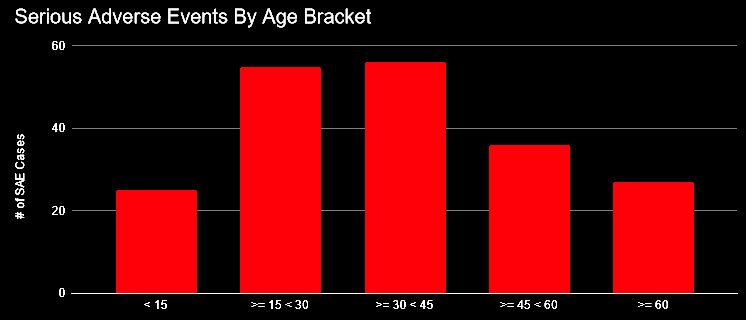
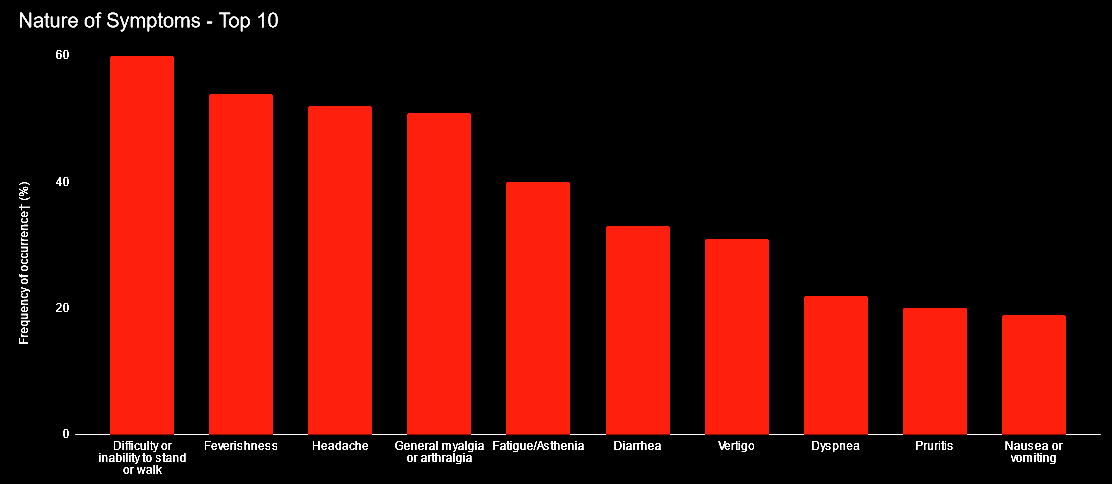
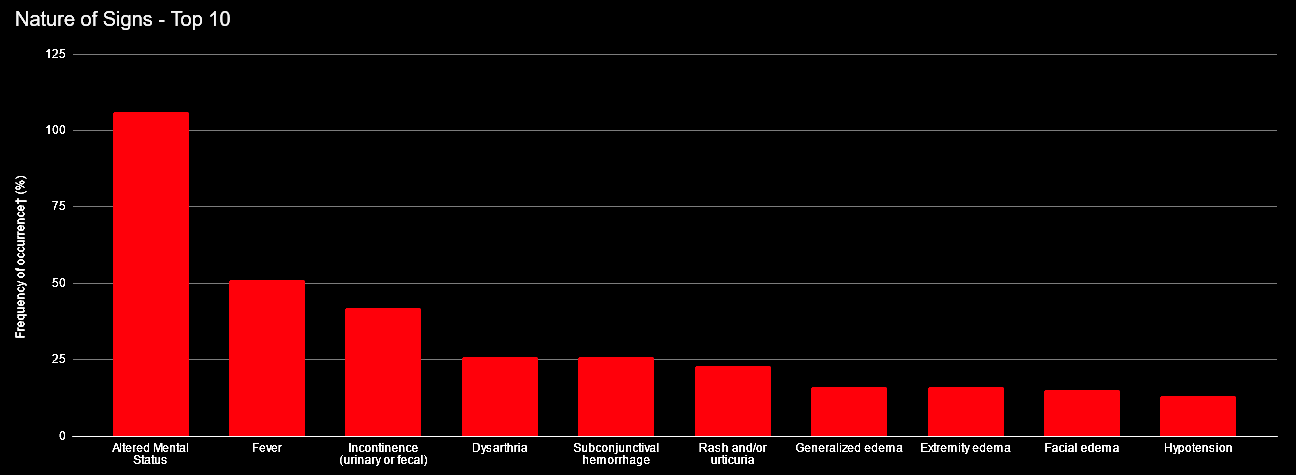
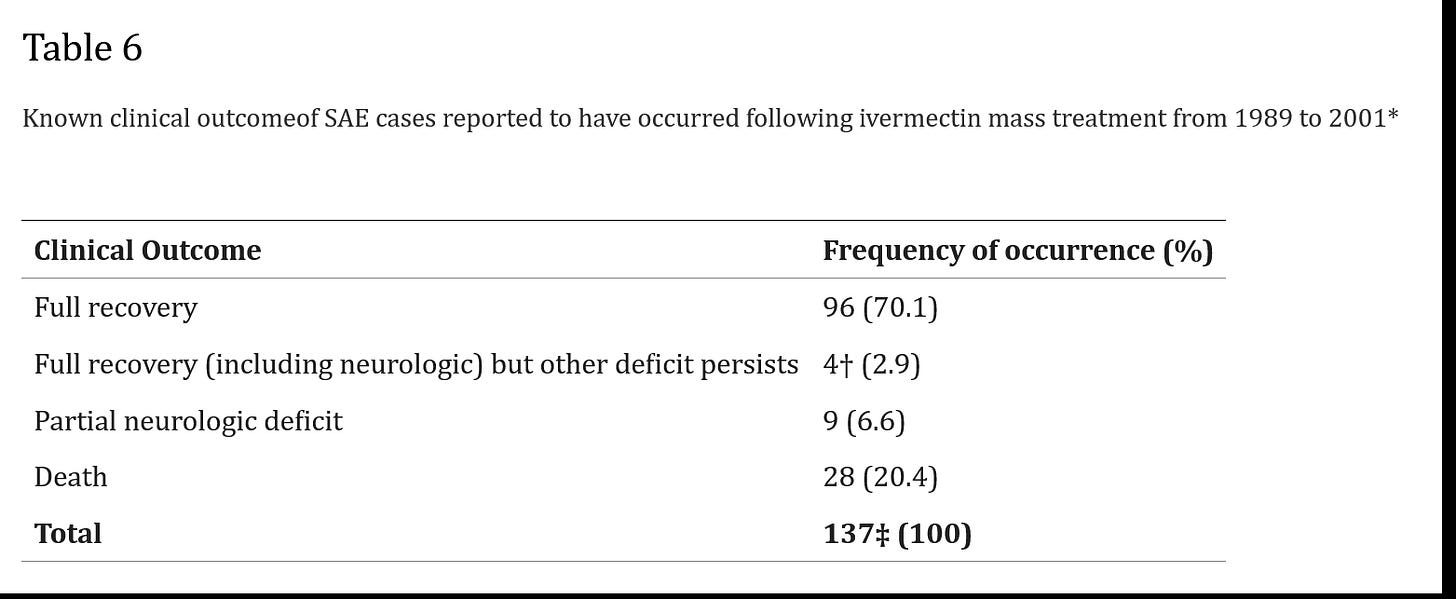

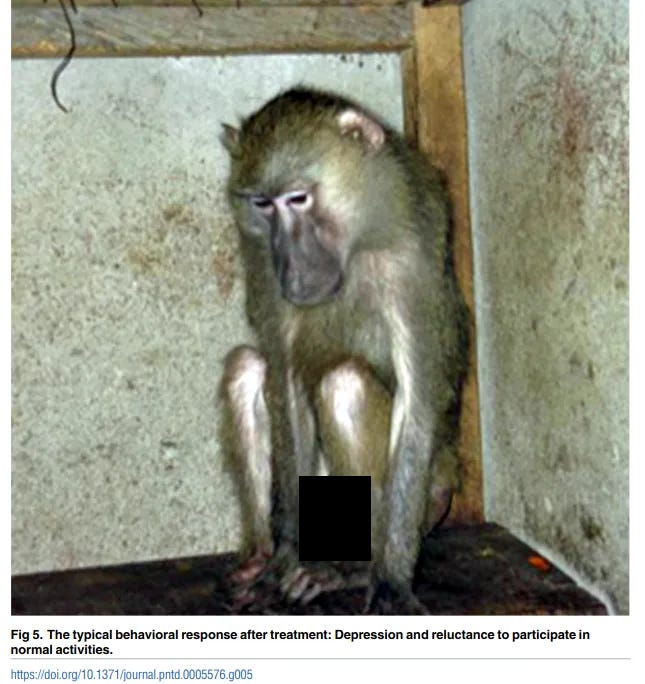
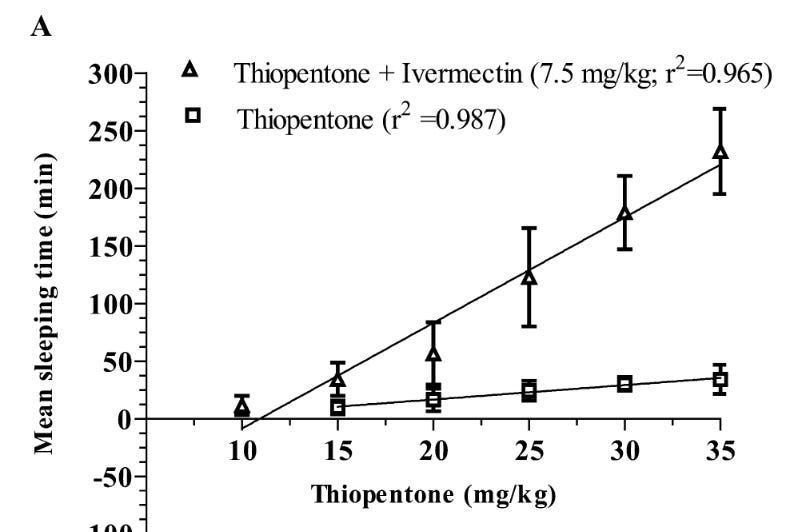

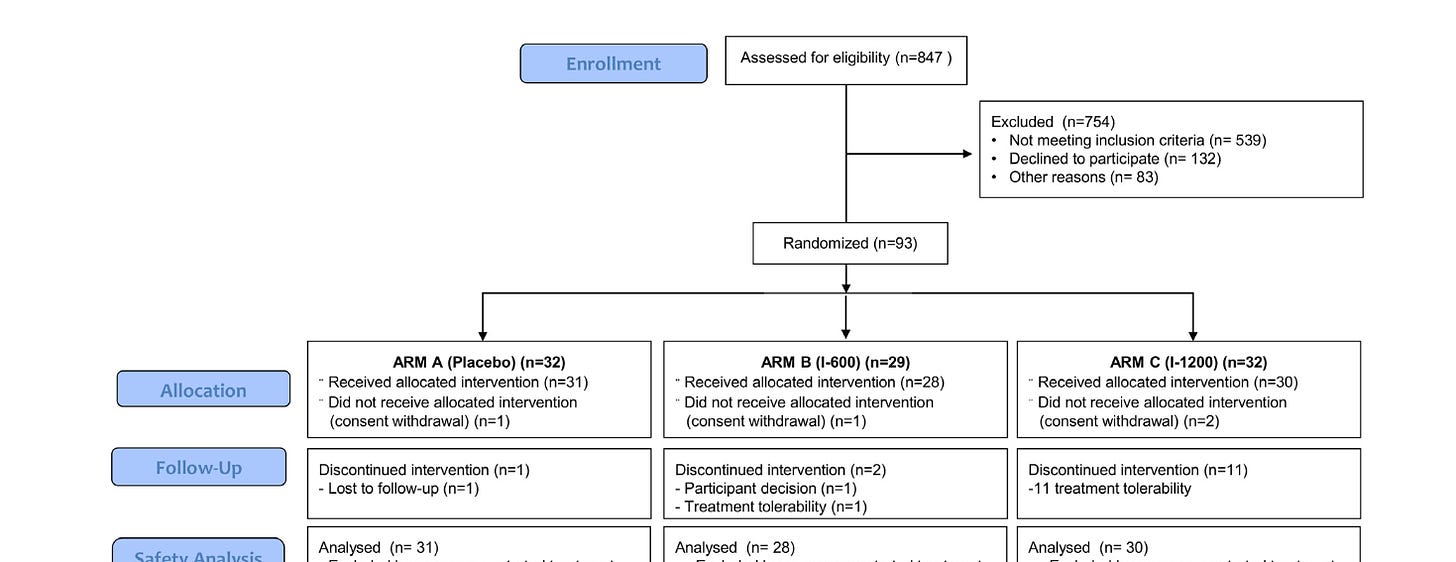
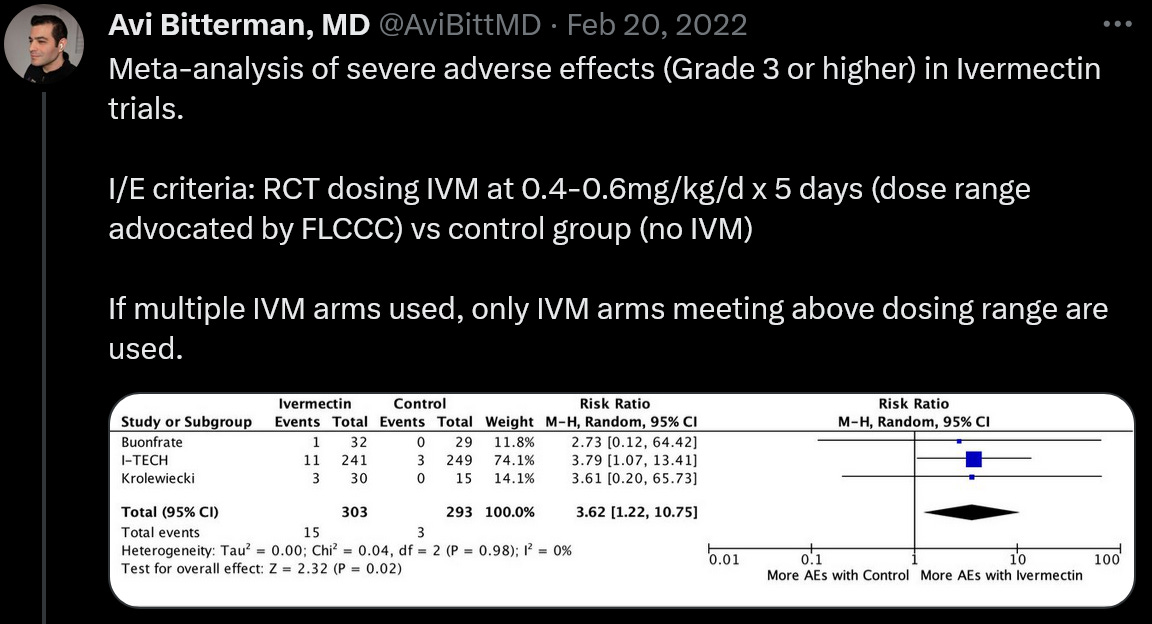
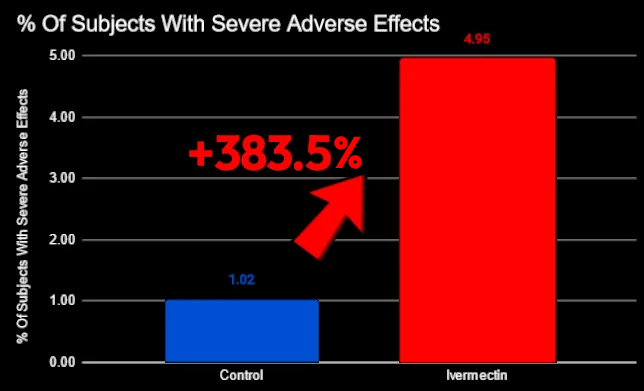
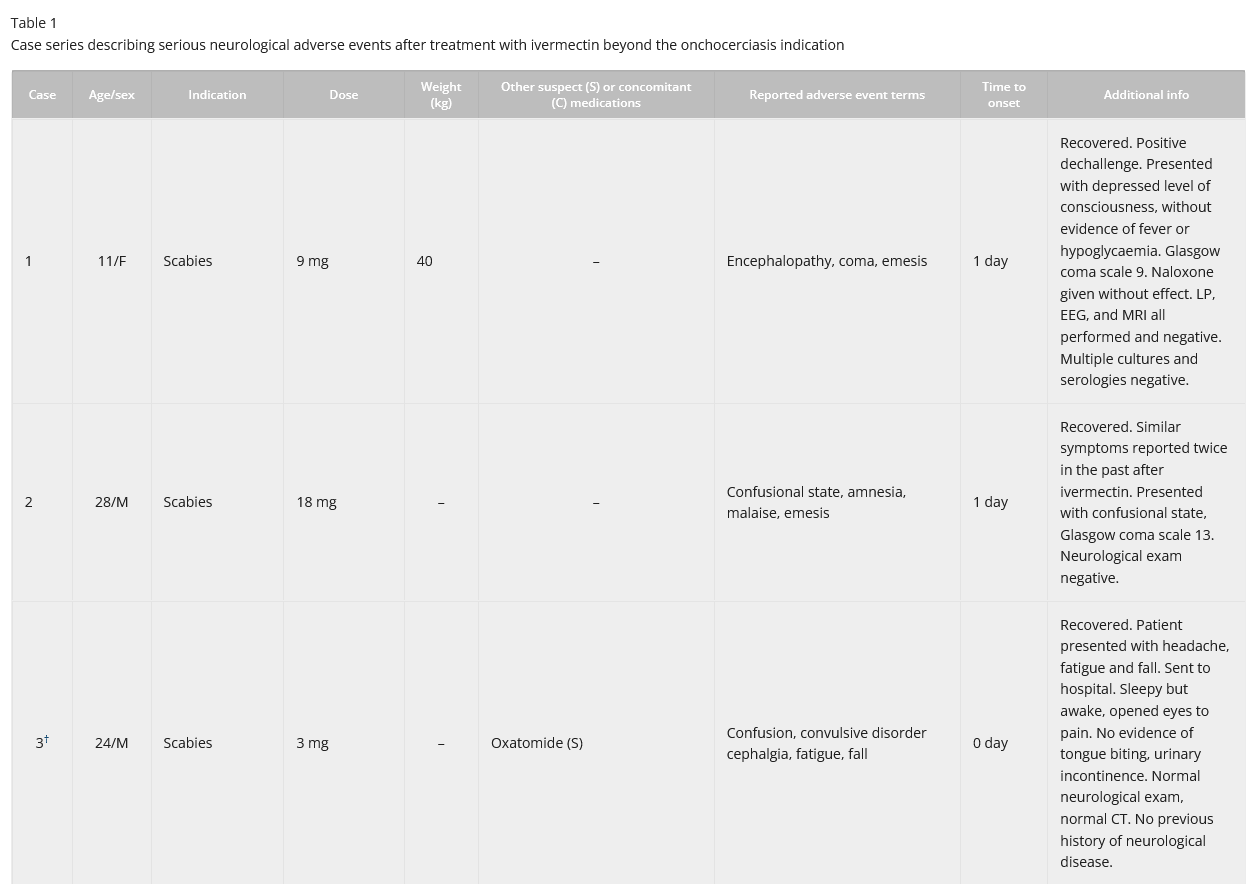

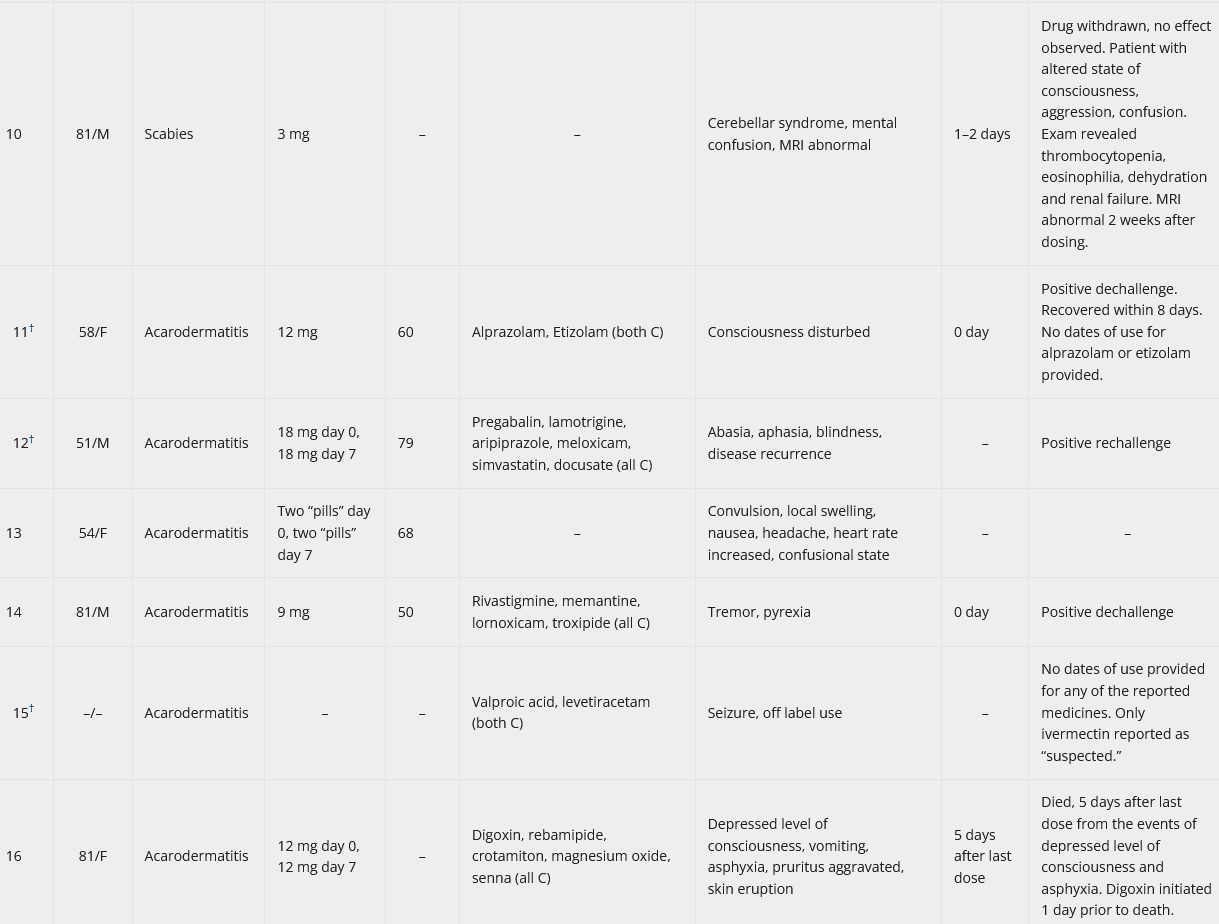
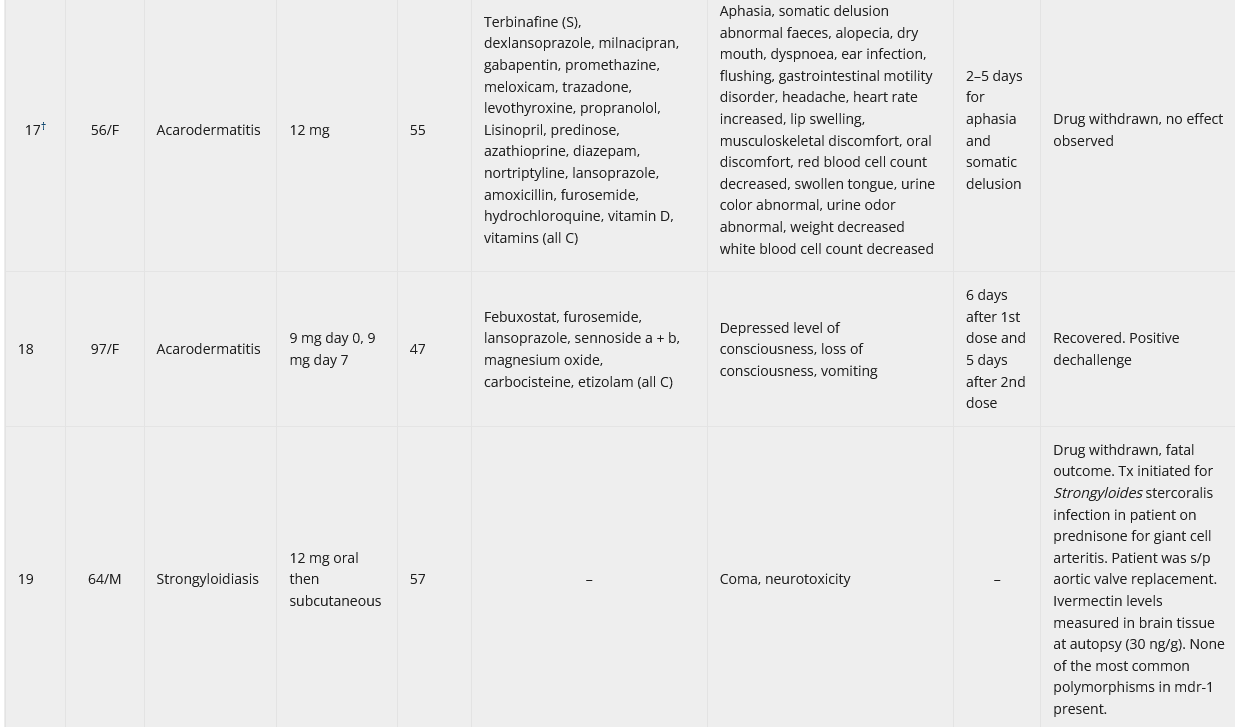
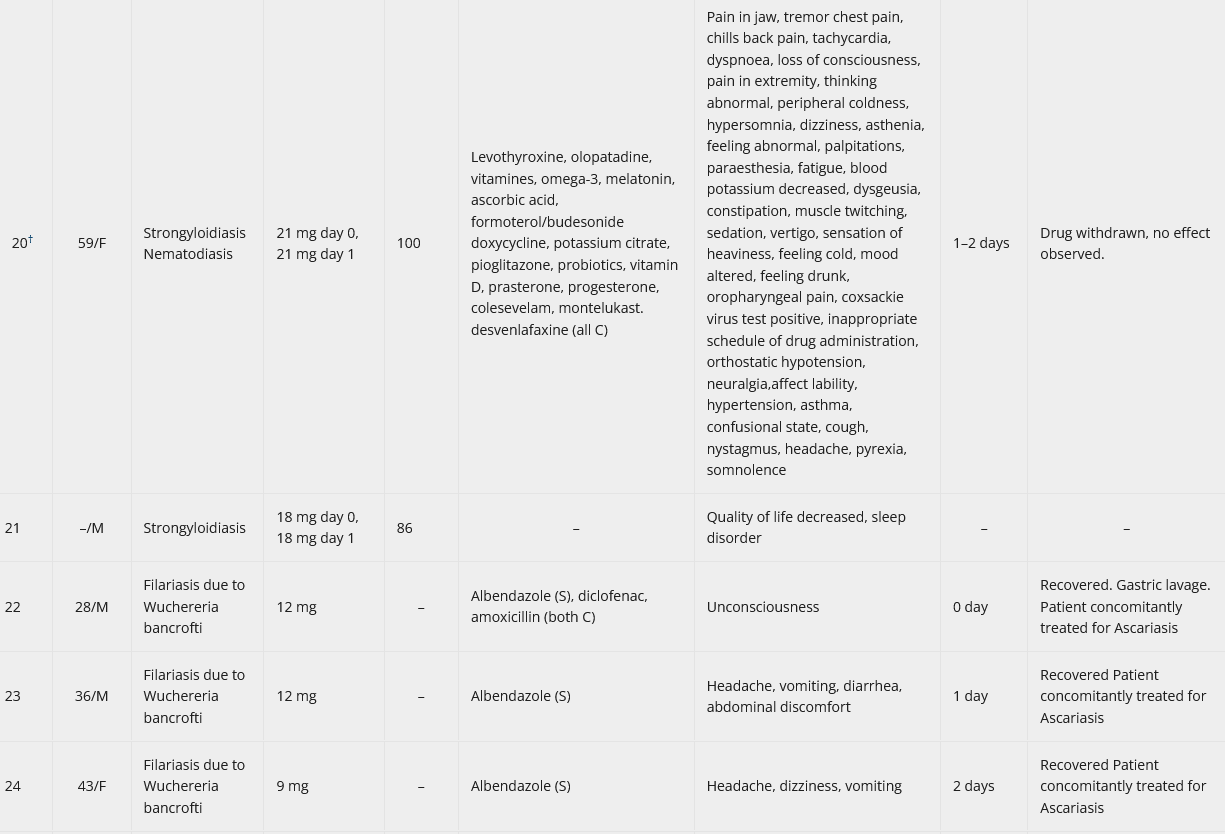
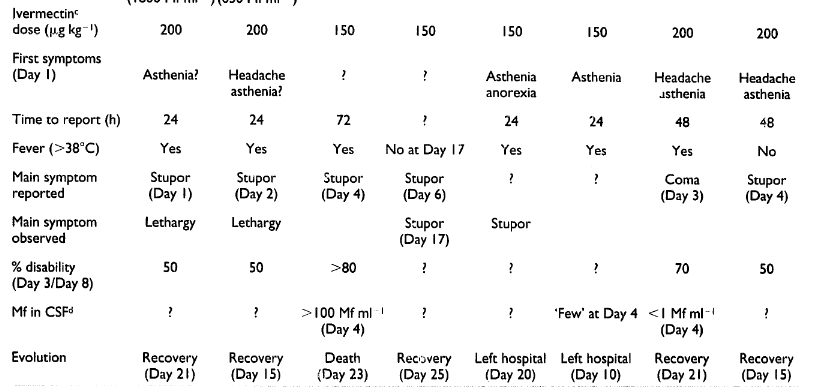
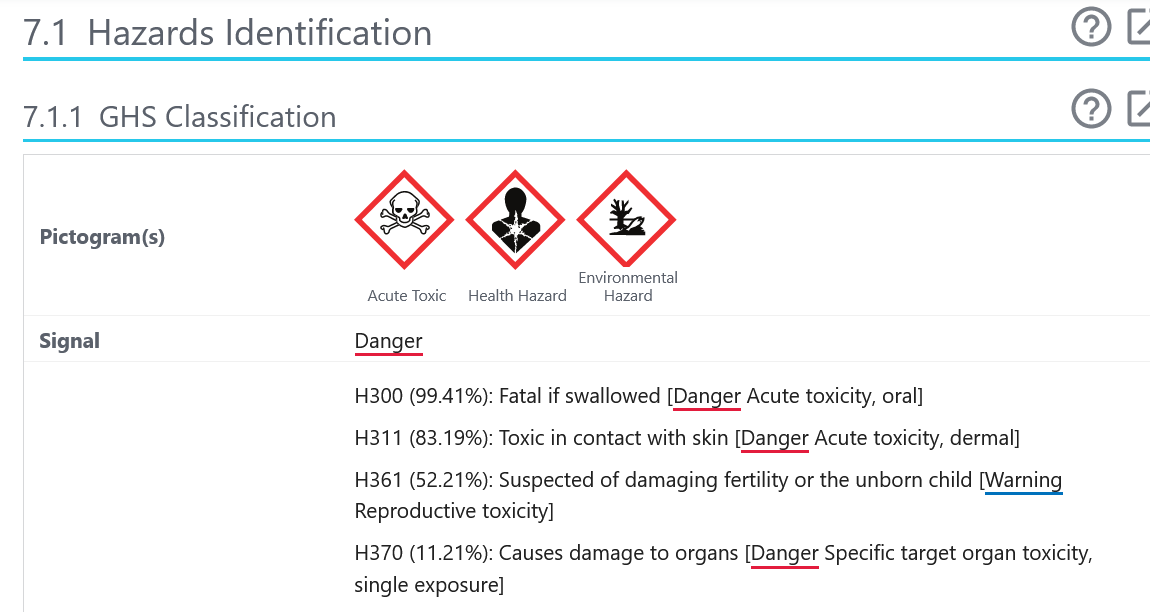




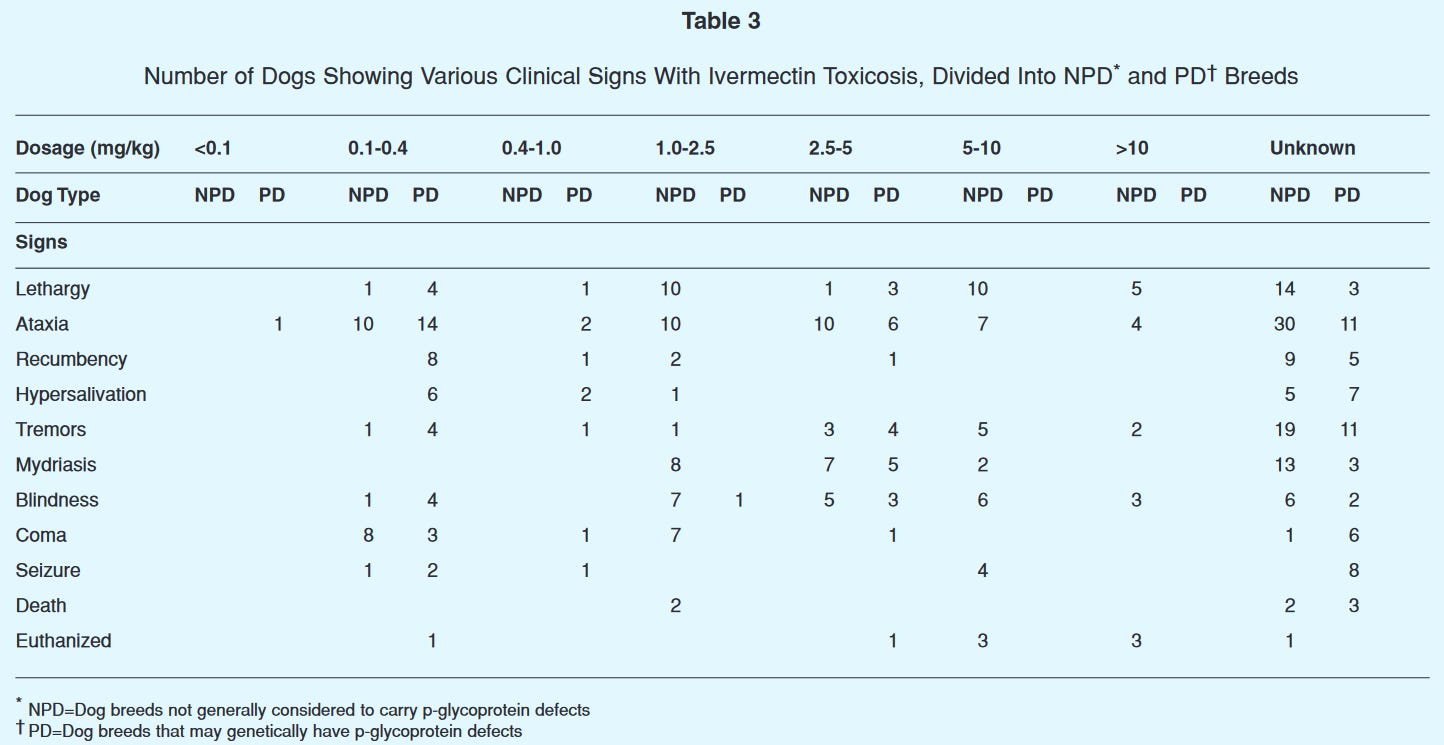
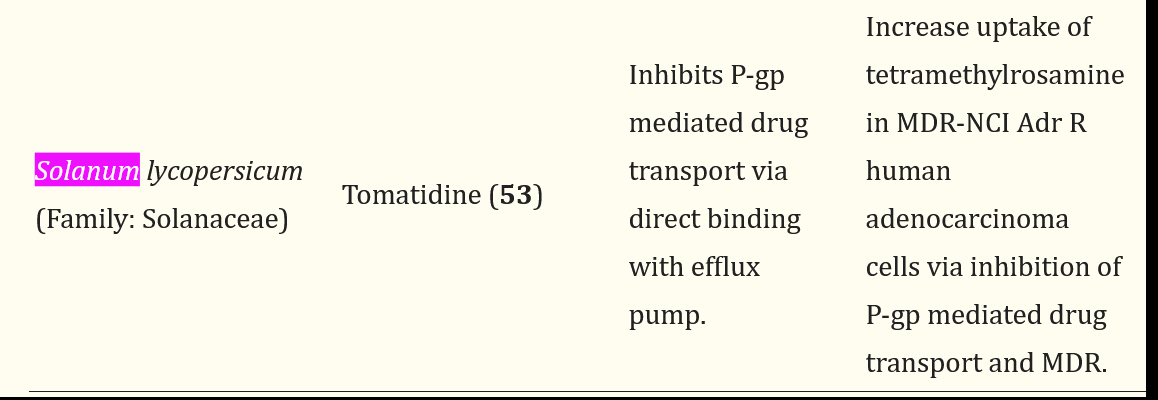
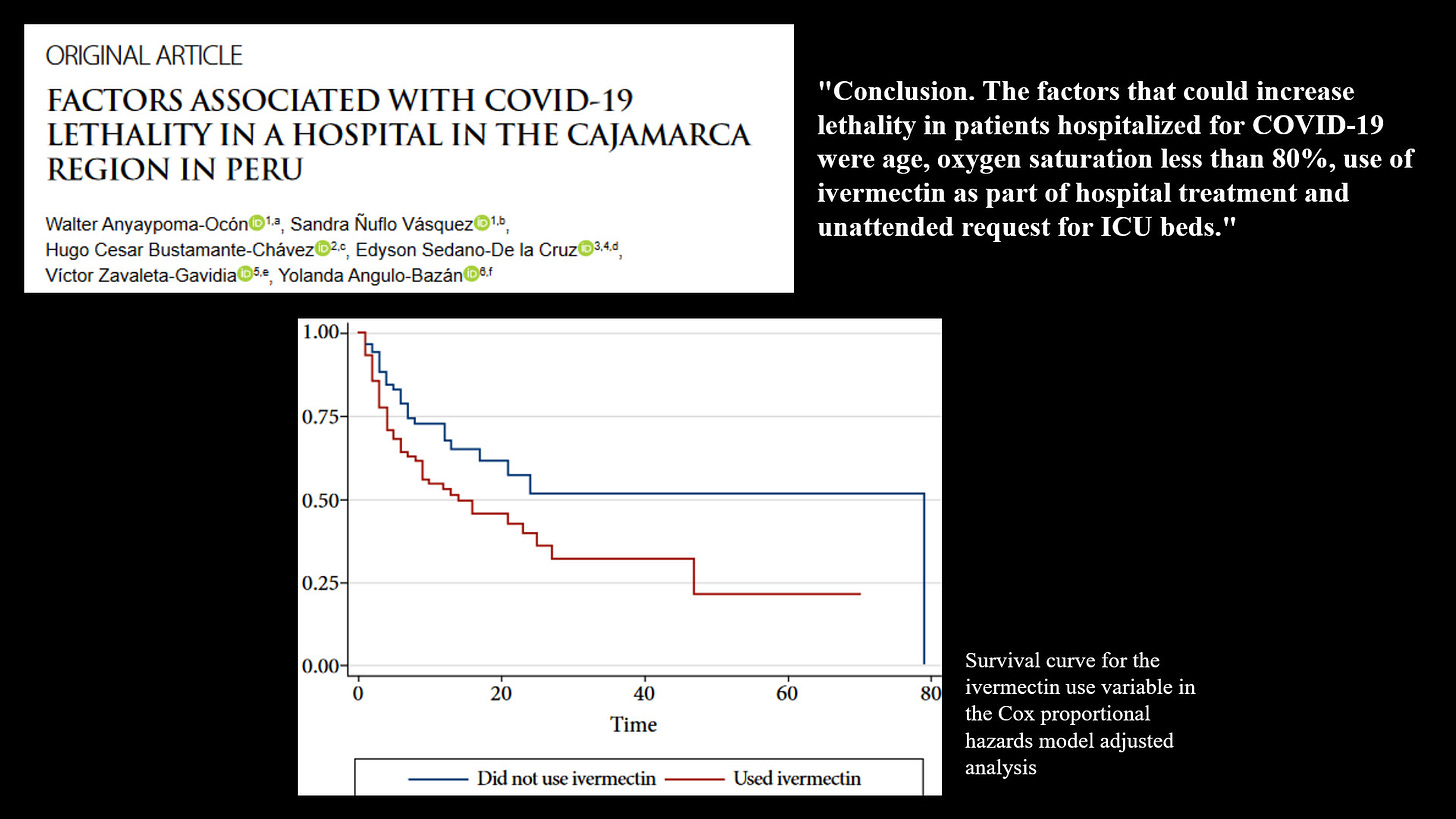

No comments:
Post a Comment